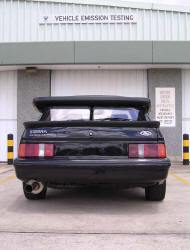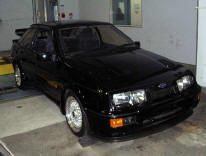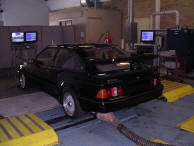

Chalker know all to well the difficulties RS Cosworth's have to meet Australian design rules and statutory registration requirements. We can currently comply Sierra Cosworth - 3 door, RS500 and Sapphire 2wd variants to comply with these design rules. Some of the major ADR's concern side impact protection and emission standards
As part of our vehicle compliancing, Chalker has developed strategies to pass the very demanding IM240 emissions test. This test is part of vehicle engineering certification to Australian Standards and allows the vehicle to be registered in any State. The ability of the vehicle to pass the test is largely dependant on the condition of the engine including modifications, its state of tune and condition of the vehicles associated emissions equipment.
 The IM240 was
developed by the Environmental Protection Agency (EPA) and RTA to help reduce
ozone and carbon monoxide (CO) pollution. While both the idle test and the IM240
were designed to detect high emitters of these pollutants they measure these
pollutants differently. Unlike the idle test, the IM240 measures emissions while
the vehicle is driven on a treadmill-like device called a dynamometer, which
serves to simulate real world driving conditions.
The IM240 was
developed by the Environmental Protection Agency (EPA) and RTA to help reduce
ozone and carbon monoxide (CO) pollution. While both the idle test and the IM240
were designed to detect high emitters of these pollutants they measure these
pollutants differently. Unlike the idle test, the IM240 measures emissions while
the vehicle is driven on a treadmill-like device called a dynamometer, which
serves to simulate real world driving conditions.
 The
test measures all important pollutants including HC, CO, and NOX. It also
measures fuel economy and generates diagnostic information that helps in the
repair process for vehicles that fail the test. Using the diagnostic output of
the IM240, repair technicians can more accurately determine what is wrong with
your car leading to less pollution from your vehicle and reducing the time and
money you spend on repairs
The
test measures all important pollutants including HC, CO, and NOX. It also
measures fuel economy and generates diagnostic information that helps in the
repair process for vehicles that fail the test. Using the diagnostic output of
the IM240, repair technicians can more accurately determine what is wrong with
your car leading to less pollution from your vehicle and reducing the time and
money you spend on repairs
THE IM240 TEST
The actual IM240 test is fully automated and begins with a trained inspector driving your vehicle onto the dynamometer. The vehicle is restrained, an exhaust collection device is fitted onto the exhaust, and a cooling fan placed in front of the engine. The inspector "drives" the vehicle, rather like "driving" a car on a video racing game, and consists of applying the accelerator and brakes according to a prescribed cycle displayed on a computerized video screen. The cleaner the car, the shorter the test. The maximum test-time is four minutes (which is where the 240 in IM240 comes from). Car owners may worry that there could be some damage to their car, but this rarely occurs. A thorough safety inspection is made on cars prior to the test and the driving operation of the vehicle during the test is probably no more severe than what the vehicle experiences on its drive to the test location.